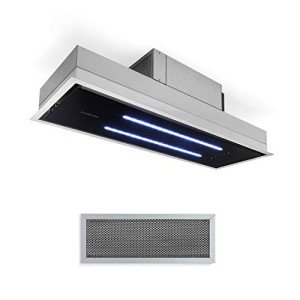Island Vent Hood Tools To Ease Your Life Everyday

How to Ventilate an Island Vent Hood
Suspended from the ceiling, an island vent hood assists distribute air and keeps your kitchen without smoke and odors. It's also a stylish feature that boosts your cooking space.
Ventilation types consist of external venting, which presses air through ductwork to the beyond your home, and recirculating designs that filter and recycle cooking fumes. Some hoods can even be converted between one and the other.
Ventilation
Unlike wall-mounted range hoods that vent air vertically through the wall to the outdoors, island vent hoods use ductwork that goes through the ceiling to exhaust the cooking location to the outdoors. The difference is that they can also be utilized to recirculate air.
Discover our selection of industrial and designer customized hoods with effective ventilation systems. With adjustable specifications, discover the ideal hood for your kitchen space.
Dacor's ConnectOn auto-responsive technology switches on the hood and ramps up the fan speed in response to the cooktop, offering effective efficiency while using very little sound. It's just another method that you can prepare with self-confidence. Include a touch of modern with this stainless-steel pyramid-style wall-mount canopy hood. This hood gracefully accents advanced kitchens that follow a more standard design style and clears the air of smoke, steam and cooking smells.
Style
Unlike wall-mounted range hoods that are mounted against the wall, island vent hoods are suspended from the ceiling over an island or peninsula cooktop or range. They likewise use ductwork to tire air out of the home. This style is ideal for kitchens that have a lot of open space, and it assists to add visual interest to your room. island cooker hood stained cherry cabinetry on the criterion, and a natural stacked stone on the island and vent hood to complement the Gunstock stain on the cabinets. 10ft ceilings and a skylight aid to keep the kitchen brilliant and roomy.
Sound
While an island vent hood does a wonderful task of filtering smoke, grease and odors out of your kitchen, it can likewise create some sound that disrupts the serenity of your cooking space. Thankfully, there are some methods you can use to lower this sound and permit you to cook in peace.
Among the main reasons for excess range hood sound is triggered by fan motor issues such as stiff bearings or badly lubricated fans that produce a loud humming sound. Ductwork can also add to this problem specifically if the ducts are too small or if they are blocked with dust.
The very best method to decrease sound is to ensure that your vent hood has the highest air flow ranking that you can pay for. The Home Ventilating Institute (HVI) advises an airflow rate of 100 to 250 cfm for wall-mounted hoods over 30-inch wide stoves. This hood must likewise have a multispeed fan to allow lower fan speeds throughout light cooking. One of the most basic ways to minimize the sound is to make sure that the ducting is smooth-walled, as corrugated duct restricts airflow. You should also keep the duct runs as brief and straight as possible to avoid any kinking.
Setup
Ventilation of island range hoods is a various procedure than wall-mounted units, given that they are suspended from the ceiling over an island or peninsula cooktop or stove. They usually require a duct that goes through the ceiling and out through the roof, which can be a complex job for an unexperienced house owner.
In addition, they need to be installed a minimum of 24-inches to 36-inches above the cooking surface. The height may differ, depending on the size of the hood and the ceiling. If you have existing ducting and electrical wiring in the kitchen ceiling, this type of vent hood is reasonably simple to install. If not, it's recommended that you consult a professional.
To start installation, make certain the hood can fit through the opening you have actually chosen for the vent and that it's the right width to accommodate the ductwork and exhaust. If the hood is too wide, it can lessen the effectiveness of the vent and will increase noise levels. Next, cut a little hole in the ceiling and use a wire cutter to check that there's no plumbing or electrical circuitry near the hole. If there is, think about hiring an expert for the task or changing to a recirculating unit.

If there isn't, you can begin the larger vent hole by drilling locator holes with a drill and a 1/2-inch masonry bit in each corner of the place. Then use a jigsaw to cut the bigger vent hole. Finally, include a drywall spot and paint to finish the task. When the hood remains in location, you can run the electrical wiring and link it to your breaker box. Follow your producer's guidelines for total installation information.
